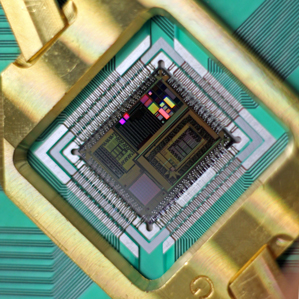Three Questions with the CEO of D-Wave
Ever since D-Wave Systems unveiled what it called the world’s first quantum computer in 2007, the small Canadian company has attracted controversy.

Computers capable of exploiting quantum physics for computation on a large scale promise to solve in mere seconds problems that would take conventional machines millions of years. But whether D-Wave’s machine uses quantum tricks to process data more efficiently is still an open question. Nonetheless, the company has attracted significant investment funding, and it has struck deals to supply its hardware to companies including Google and Lockheed Martin for research (see “The CIA and Jeff Bezos Bet on Quantum Computing”).
D-Wave’s CEO, Vern Brownell, met recently with Tom Simonite, MIT Technology Review’s San Francisco bureau chief, and said the company now has customers using its computers to tackle real problems.
By now you have built a few generations of your quantum processors. Are they ready to be used to solve problems yet?
We have 12 machines running now. A few of them are online; we have customers who can access a machine over the Internet. It’s not a product or something that’s available to everyone, but we have customers doing real things with the computer today that have huge business impact. We have seen results that are better than classical systems. Customers have their application and integrate quantum computing into it and it performs better.
Over the next few years we will be offering more and more of that capability to the world. We see us eventually making quantum cloud services available to the world. But we don’t have a tool set yet that allows us to do that. It requires a lot of hand-holding with even the most sophisticated customers.

Can you give some examples of what those customers are using D-Wave’s machines for?
[A company called] 1Qbit was started to use our quantum computer for financial services. They have 20 PhDs developing algorithms in portfolio optimization and things like that. We provide them with some training and expertise, but they are by and large doing this work themselves. If they find the amazing algorithm that is going to make tons of money for Wall Street traders, it’s their intellectual property, not ours.
Another example is DNA-Seq, doing cancer therapy based on new drugs. They try to understand the molecular interactions of proteins called kinases. Understanding very low-level molecular interactions is a computationally huge problem. They are not solely based around quantum computing, but they see it as an enabler of what they are doing.
Outside your company and its partners, there is still skepticism that D-Wave even has a quantum computer.
There’s rightfully a lot of attention on benchmarking our system. I think you’ll see in the next little while some important third-party results that say what we’ve been saying all along—we can demonstrate speedups over classical algorithms in certain narrow cases. Those are results that you won’t see from us; it’s more credible for one of our partners to do that. It is going to be an important milestone for us. If you want to do something practical with quantum computing, we’re the only place you can come.
Keep Reading
Most Popular
Large language models can do jaw-dropping things. But nobody knows exactly why.
And that's a problem. Figuring it out is one of the biggest scientific puzzles of our time and a crucial step towards controlling more powerful future models.
The problem with plug-in hybrids? Their drivers.
Plug-in hybrids are often sold as a transition to EVs, but new data from Europe shows we’re still underestimating the emissions they produce.
Google DeepMind’s new generative model makes Super Mario–like games from scratch
Genie learns how to control games by watching hours and hours of video. It could help train next-gen robots too.
How scientists traced a mysterious covid case back to six toilets
When wastewater surveillance turns into a hunt for a single infected individual, the ethics get tricky.
Stay connected
Get the latest updates from
MIT Technology Review
Discover special offers, top stories, upcoming events, and more.